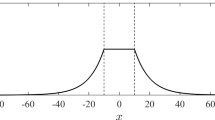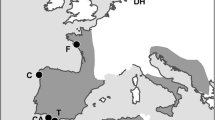Abstract
Syneilesis palmata reproduces by both seeds and vegetative propagules (short rhizomes). The latter result in the production of new plants that are larger in size and hence have a higher survival probability and a higher growth rate than seeds. A previous study predicted that the optimal reproductive strategy, in terms of maximizing population growth rate (a fitness measure under no density regulations), was pure vegetative reproduction. However, high resource investment to vegetative propagules can cause local crowding resulting in reduced demographic performances of the plants, because the vegetative propagules of Syneilesis are produced close to one another. We examined, in this situation, the impact of allocating a certain proportion of reproductive resource to seeds with relatively greater capacity for dispersal. We simulated dynamics of hypothetical Syneilesis populations with various reproductive resource allocation balances (from pure seed to pure vegetative reproduction), using a density-dependent matrix model. In the model, it was assumed that plants from vegetative propagules experienced density-dependent reduction in their survival probabilities, but this was not the case for plants originating from seeds. Each allocation strategy was evaluated based on an equilibrium population density, a fitness measure under density-dependent regulations. The optimal reproductive strategy predicted was pure vegetative reproduction. Unrealistic conditions were required for seed reproduction to be favoured, such as the production of seeds one hundred times the normal number per unit resource investment. However, the conditions were fairly relaxed compared with those required in the model where no density effects were incorporated. This indicates that escape from local crowding is likely to be one of the roles of seed production in Syneilesis.
Similar content being viewed by others
References
American Genetic Association 1993. AGA symposium issue: evolution of sex. J. Hered. 84: 321–424.
Bell, G. 1985. Two theories of sex and variation. Experientia 41: 1235–1245.
Bierzychudek, P. 1982. The demography of jack-in-the-pulpit, a forest perennial that changes sex. Ecol. Monogr. 52: 335–351.
Calvo, R. N. 1993. Evolutionary demography of orchids: intensity and frequency of pollination and the cost of fruiting. Ecology 74: 1033–1042.
Caswell, H. 1982. Stable population structure and reproductive value for populations with complex life cycles. Ecology 63: 1223–1231.
Caswell, H. 1985. The evolutionary demography of clonal reproduction. Pp. 187–224. In: Jackson, J. B. C., Buss, L. W. & Cook, R. E. (eds), Population biology and evolution of clonal organisms. Yale University Press, New Haven.
Caswell, H. 1988. Approaching size and age in matrix population models. Pp. 85–105. In: Ebenman, B. & Persson, L. (eds), Sizestructured populations. Springer-Verlag, Berlin.
Caswell, H. 1989. Matrix population models. Sinauer Associates, Massachusetts.
Charlesworth, B. 1994. Evolution in age structured populations, 2nds edition. Cambridge University Press, Cambridge.
Cipollini, M. L., Whigham, D. F. & O'Neill, J. 1993. Population growth, structure, and seed dispersal in the understory herb Cynoglossum virginianum: a population and patch dynamic model. Plant Species Biol. 8: 117–129.
Fowler, N. 1988. The effects of environmental heterogeneity in space and time on the regulation of populations and communities. Pp. 249–269. In: Davy, A. J., Hutchings, M. J. & Watkinson, A. R. (eds), Plant population ecology. Blackwell Scientific Publications, Oxford.
Gillman, M., Bullock, J. M., Silvertown, J. & Hill, B. C. 1993. A density-dependent model of Cirsium vulgare population dynamics using field-estimated parameter values. Oecologia 96: 282–289.
Hanski, I., Kuussaari, M. & Nieminen, M. 1994. Metapopulation structure and migration in the butterfly Melitaea cinxia. Ecology 75: 747–762.
Harada, Y. & Iwasa, Y. 1994. Lattice population dynamics for plants with dispersing seeds and vegetative propagation. Res. Popul. Ecol. 36: 237–249.
Horvitz, C. C. & Schemske, D.W. 1986. Seed dispersal and environmental heterogeneity in a neotropical herb: amodel of population and patch dynamics. Pp. 169–186. In: Estrada, A. & Fleming, T. H. (eds), Frugivore and seed dispersal. DrW. Junk Publishers, Dordrecht.
Hurst, L. D. & Peck, J. L. 1996. Recent advances in understanding of the evolution and maintenance of sex. Trends Ecol. Evol. 11: 46–52.
Iwasa, Y. 1990. Evolution of the selfing rate and resource allocation models. Plant Species Biol. 5: 19–30.
Kakehashi, M. & Harada, Y. 1987. A theory of reproductive allocation based on size-specific demography. Plant Species Biol. 2: 1–13.
Koyama, H. 1965. Cytotaxonomic studies of compositae 1. Species problem on Syneilesis tagawae. Acta Phytotax. Geobot. 21: 129–132.
Koyama, H. 1967. Taxonomic studies on the tribe Senecioneae of Eastern Asia I. General part. Mem. Coll. Sci. Univ. Kyoto, Ser. B 33: 181–209.
Lefkovitch, L. P. 1965. The study of population growth in organisms grouped by stages. Biometrics 21: 1–18.
Maynard Smith, J. 1989. Evolutionary genetics. Oxford University Press, Oxford.
Michod, R. E. & Levin, B. R. 1988. The evolution of sex: an examination of current ideas. Sinauer Associates Inc., Massachusetts.
Nishitani, S. 1993. Reproductive ecology of Syneilesis palmata (Compositae). Thesis, Tokyo Metropolitan University.
Nishitani, S. & Kimura, M. 1993. Resource allocation to sexual and vegetative reproduction in a forest herb Syneilesis palmata (Compositae). Ecol. Res. 8: 173–183.
Nishitani, S. & Kimura, M. 1995. Contrasting demographic characteristics of seeds and vegetative propagules in an understory herb Syneilesis palmata (Compositae). Plant Species Biol. 10: 1–10.
Nishitani, S., Takada, T. & Kachi, N. 1995. Optimal resource allocation to seeds and vegetative propagules in the understory herb Syneilesis palmata (Compositae). Plant Species Biol. 10: 127–135.
Nunney, L. 1989. The maintenance of sex by group selection. Evolution 43: 245–257.
Perry, J. N. & Gonzalez-Andujar, J. L. 1993. Dispersal in ametapopulation neighborhood model of an annual plant with a seed bank. J. Ecol. 81: 453–463.
Roff, D. A. 1992. The evolution of life histories – theory and analysis. Chapman & Hall, New York.
Roughgarden, J. 1979. Theory of population genetics and evolutionary ecology: an introduction. Macmillan Publishing Co., Inc., New York.
Sarukhan, J. 1974. Studies on plant demography: Ranunculus repens L., R. bulbosus L. and R. acris L. II. Reproductive strategies and seed population dynamics. J. Ecol. 62: 151–177.
Schellner, R. A., Newell, S. J. & Solbrig, O. T. 1982. Studies on the population biology of the genus Viola. IV. Spatial pattern of ramets and seedlings in three stoloniferous species. J. Ecol. 70: 273–290.
Schnee, B. K. & Waller, D. M. 1986. Reproductive behavior of Amphicarpaea bracteata (Leguminosae), an amphicarpic annual. Amer. J. Bot. 73: 376–386.
Stearns, S. C. 1985. The evolution of sex and the role of sex in evolution. Experientia 41: 1231–1235.
Takada, T. 1995. Evolution of semelparous and iteroparous perennial plants: comparison between the density-independent and density-dependent dynamics. J. theor. Biol. 173: 51–60.
Takada, T. & Nakajima, H. 1992. An analysis of life history evolution in terms of the density-dependent Lefkovitch matrix model. Math. Biosci. 112: 155–176.
Takada, T. & Nakajima, H. 1996. The optimal allocation for seed reproduction and vegetative reproduction in perennial plants: an application to the density-dependent transition matrix model. J. Theor. Biol. 182: 179–191.
Takada, T. & Nakajima, H. 1998. Theorems on the invasion process in stage-structured populations with density-dependent dynamics. J. Math. Biol. 36(in press).
Takada, T. & Nakashizuka, T. 1996. Density-dependent demography in a Japanese temperate broad-leaved forest. Vegetatio 124: 211–221.
van Groenendael, J., de Kroon, H. & Caswell, H. 1988. Projection matrices in population biology. Trends Ecol. Evol. 3: 264–269.
Venable, D. L. & Brown, J. S. 1988. The selective interactions of dispersal, dormancy, and seed size as adaptations for reducing risk in variable environments. Amer. Natur. 131: 360–384.
Werner, P. A. & Caswell, H. 1977. Population growth rates and age versus stage-distribution models for teasel (Dipsacus sylvestris Huds.). Ecology 58: 1103–1111.
Zeide, B. 1977. Reproductive behavior of plants in time. Amer. Natur. 112: 636–639.
Author information
Authors and Affiliations
Rights and permissions
About this article
Cite this article
Nishitani, S., Takada, T. & Kachi, N. Optimal resource allocation to seeds and vegetative propagules under density-dependent regulation in Syneilesis palmata (Compositae). Plant Ecology 141, 179–189 (1999). https://doi.org/10.1023/A:1009896111536
Issue Date:
DOI: https://doi.org/10.1023/A:1009896111536




